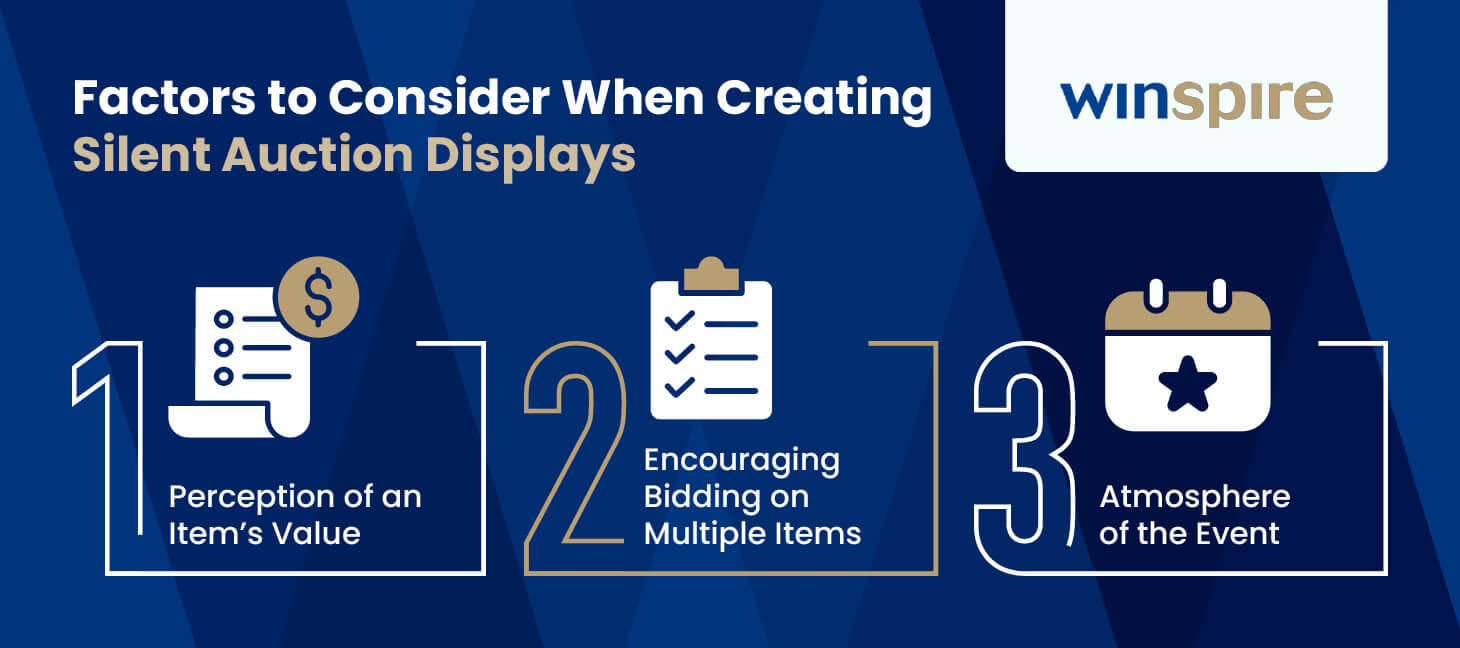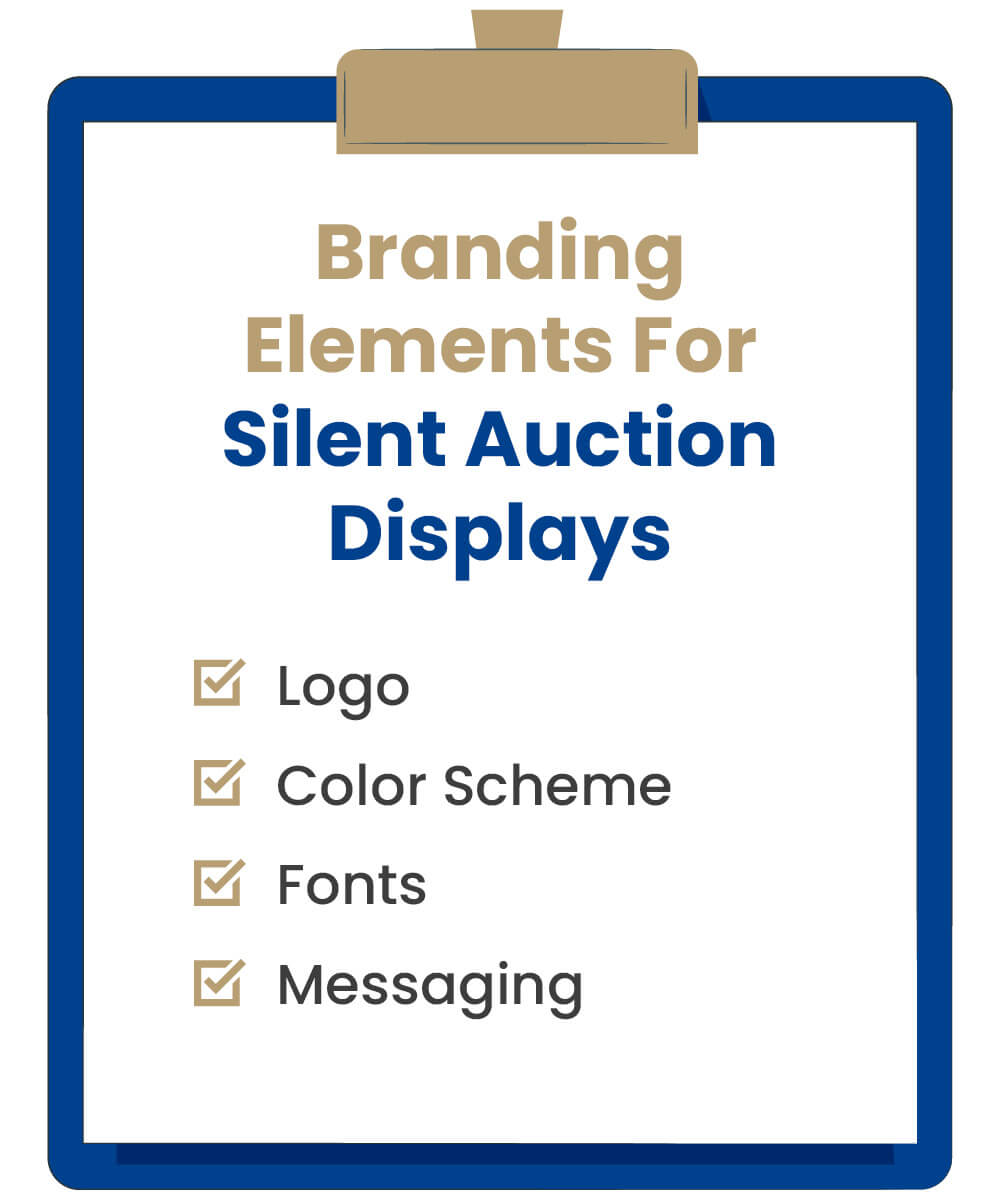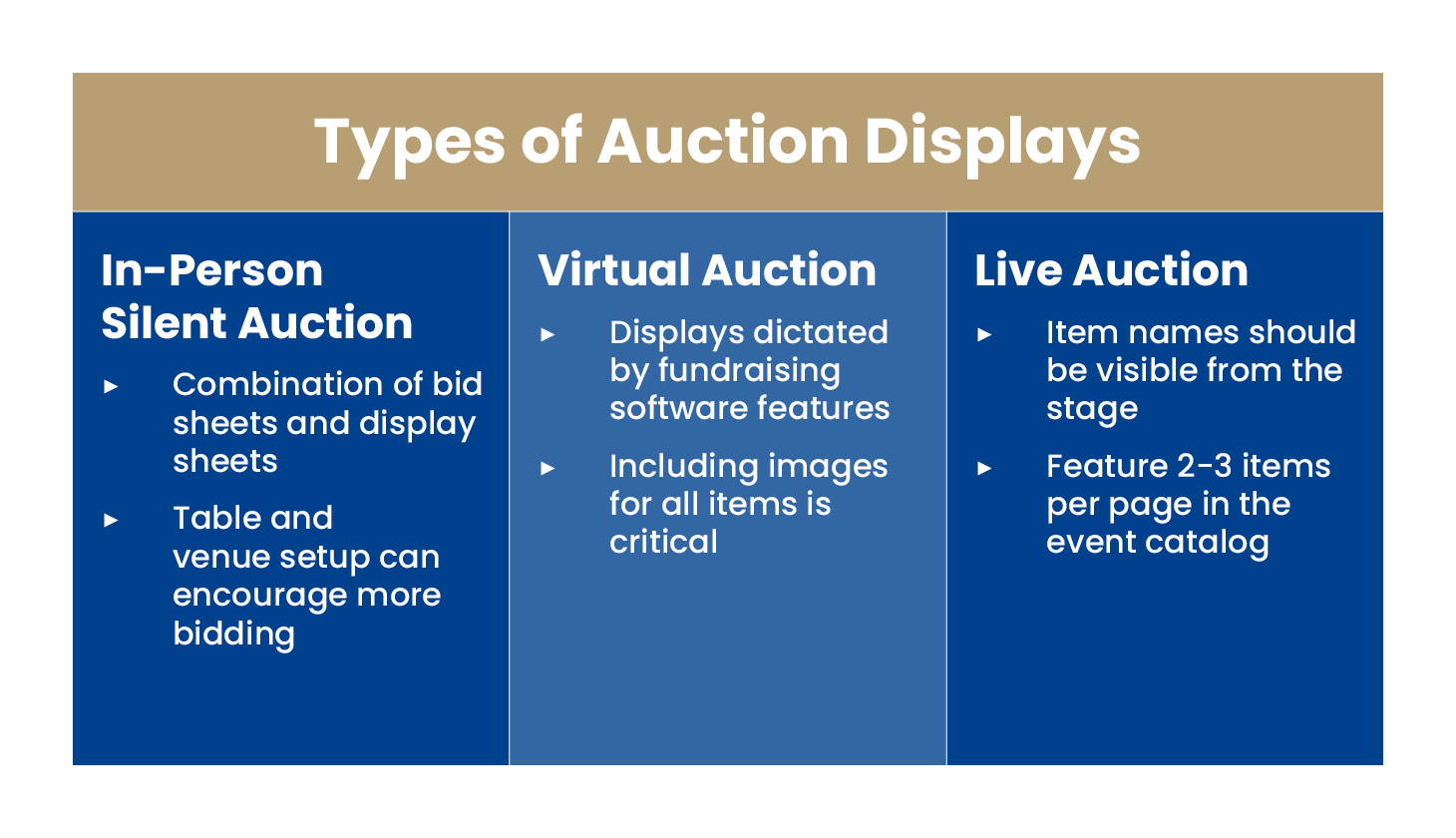The focal points of any silent auction are the items featured. While many of your event participants will attend with the primary goal of contributing to your nonprofit’s mission, they receive the added benefit of winning prizes to take home. Some attendees might even sign up because they want to find unique, high-value items at a lower cost than they would elsewhere and are happy to support a good cause in the process.
Getting supporters to place bids depends not only on what silent auction items you procure, but also on how you display them. In this guide, you’ll learn everything you need to know about creating standout silent auction displays, including:
- Why are silent auction displays important?
- Top Silent Auction Display Ideas
- Other Types of Auction Item Displays
- Procure Attention-Grabbing Silent Auction Items With Winspire
Let’s get started by diving deeper into the reasons effective silent auction displays are so critical.
Why are silent auction displays important?
While the major benefit of effectively displaying your silent auction items is generating more bids at higher values, the reason this occurs is slightly more complex than it may seem at first glance. There are several different factors you should keep in mind as you design your displays to appeal to your supporters, including:
- How participants perceive an item’s value. This depends not only on the starting bid amount you set for a prize, but also on the way it looks. For instance, supporters will perceive a gift basket as more valuable if it’s neatly packaged and appears full than if it’s disorganized and has obvious empty spaces.
- Whether you can prompt supporters to bid on multiple items. The best way to do this is to put related items next to each other. Then, if a participant is looking for a certain type of item, they can quickly enter several different competitions to increase their chances of winning one. For example, grouping all of your travel packages together would allow a supporter who really wants to win a vacation to bid on trips to all of their favorite destinations at the same time.
- What type of atmosphere you create at the auction. While the best ambience for your event will depend on your audience’s preferences, supporters should always get an impression of professionalism and feel the friendly competition during the bidding—both of which depend on well-organized, intentional displays.
For physical goods, their presence on the table at your auction along with the information on the bid sheet and display sheet all contribute to the effectiveness of the item’s display. If the prize isn’t tangible (such as an experience) or shouldn’t be left lying around (like a gift certificate), the display sheet becomes even more critical for inspiring bids. Fortunately, there are plenty of templates available online to help you create the best possible display sheets.
Top Silent Auction Display Ideas
Now that you know why silent auction displays matter and what to keep in mind as you create them, let’s walk through some tips for effectively displaying your auction items.
Incorporate Your Nonprofit’s Branding
The primary purpose of branding is to make your organization more recognizable and memorable to supporters. Seeing your branding featured in displays throughout your silent auction will help cement that brand recognition for participants, as well as reminding them about the cause the winning bids will support. Consistent branding also adds a level of professionalism to your displays, especially if they match the visual style of your bid sheets and event signage.
Make sure to include the following brand elements on each of your display sheets:
- Logo. As the symbol that represents your entire organization, your logo is the most important element to repeat throughout the event to boost brand recognition.
- Color scheme. Colorful display sheets can capture your audience’s attention, but a consistent palette will make them appear more professional and less visually overwhelming.
- Fonts. To add variety to your display sheets, use two different typefaces: one for headings and one for copy. However, don’t incorporate more than three fonts to avoid a cluttered look.
- Messaging. Branding extends beyond visuals to the way you write content for your organization, so use a consistent tone and writing style in your item descriptions.
Additionally, feature your organization’s mission statement or tagline either on your display sheets or your bid sheets to give participants a quick insight into the cause they’re supporting. If you have space, add a short blurb about how your nonprofit plans to use the funds from the auction to further that cause.
Include Compelling Images
While carefully chosen photos will enhance any silent auction display sheet, they’re especially important for items that can’t be physically displayed on the table. Since many of these prizes are intangible, add relevant images that will demonstrate why supporters should bid on that item, such as:
- Pictures of the beautiful landscapes they’ll see if they win a trip to a particular destination
- Photos of people enjoying delicious meals at a local restaurant you’re auctioning off a gift card for
- Smaller versions of the window cards for musicals or concerts they could secure tickets to
When it comes to prizes that are placed on the table, consider including images related to the item’s use or benefits on the display sheet. For instance, you could use a picture of someone listening to music with the Bluetooth headphones featured in your auction or a person enjoying a facial alongside a basket of at-home spa supplies.
Although it’s tempting to fill up your display sheet with photos, follow the principles of graphic design and keep things simple. Include two or three images per display sheet (plus one on the bid sheet if you’d like), spaced evenly and balanced out with text and white space.
Give Each Item a Catchy Title
Put yourself in your supporters’ shoes for a second. If you were attending your auction, which of the following items would you be more likely to bid on?
- The “Cooking Supplies Gift Basket” or the “Home Chef Starter Kit”?
- The “Vacation to the South of France” or the “French Countryside Chateau Getaway”?
- “Two Tickets to a Beyoncé Concert” or “The VIP Cowboy Carter Tour Experience”?
These examples show just how important the titles of your auction items can be in attracting bids. After you’ve brainstormed a creative name for each prize, make sure it stands out in large, bold type on the display sheet.
Write Thorough Item Descriptions
Once you’ve gotten participants’ attention with your item’s title and photos, describing each prize well will assist in their decision-making process about whether and how much to bid. You can write the description on the display sheet, bid sheet, or a combination of both. No matter where you include it, here are some tips to elevate your descriptions:
- Write concisely. Participants will likely encounter a lot of item descriptions in a row, so they should be able to skim each one. Keep sentences and paragraphs short, and use bullet points whenever possible.
- List everything the winning bidder will receive. Many auction prizes are bundled, so make clear what is included with each item. For example, if a concert experience includes two floor seats, merchandise, a voucher for food and drinks at the venue, and a photo opportunity with the artist, include all of that information within the display.
- Clarify any restrictions surrounding the item’s use. Supporters need to be able to make an informed decision about whether they could use and benefit from a prize before they bid on it. If a gift certificate expires or a vacation can only be taken during a certain time frame, let participants know in the description.
Your description’s text should be considerably smaller than the title but still large enough to be easily readable. This includes the item restrictions section, even though those are often considered “fine print”—it’s better for supporters to know about the limitations than to end up winning a prize they can’t use and accuse your organization of being unclear in that area.
Consider the Entire Event’s Setup
Effectively showcasing your silent auction items doesn’t just depend on creating the best possible display and bid sheets. You also need to think about how the items are set up on the tables and how the event is laid out as a whole.
As you plan your auction, make sure to consider:
- Whether your displays will be single- or multi-level. If you have the time to acquire and set up a number of clear plastic stands, elevating the items and or/display sheets above the bid sheets is often more visually interesting to participants.
- How your items will be organized. As stated previously, putting related items near each other allows supporters to find exactly what they’re looking for and encourages them to place multiple bids. However, the way in which you group prizes thematically is up to you.
- Where everything will be located at your venue. In many cases, silent auctions are accompanied by food, beverages, and socializing, so you’ll need to designate areas for those elements as well as for bidding. Your silent auction may also be paired with a live auction or a different type of fundraising event like a 5K race or golf tournament—if so, you’ll need to account for the space those activities take up.
If you need help figuring out your event’s organization, try making a quick sketch of the venue layout to guide your setup. These sketches will be unique to your nonprofit’s event plan, but here is an example to help you get started:
Other Types of Auction Item Displays
The display ideas we’ve explored so far are best suited to in-person silent auctions. But auctions are highly flexible in that they can also take place in a live format and be held online as well as in person. Naturally, these types of auctions require different considerations for item displays.
For a virtual auction, the event fundraising software you choose will dictate some aspects of your displays, such as how your nonprofit’s branding can be incorporated and how long your item descriptions can be. Make sure, however, that you can upload at least one high-quality photo related to each item—because supporters can’t physically see any of your items, having an image to base their decision on is even more critical.
At live auctions, the displays involve a combination of how each item appears onstage and its listing in the auction catalog. During the event, bring out one prize at a time and ensure a sign with its title is visible from the back row of participant seating. The catalog should follow similar principles to your silent auction displays as far as branding, imagery, and item titles and descriptions go, although you’ll have a bit less space for these things if you want to fit two to three items on each page.
Procure Attention-Grabbing Silent Auction Items With Winspire
While the way you display your silent auction items is critical for attracting bids, the prizes you feature are even more critical. Vacation packages tend to be the top-selling category of charity auction item because of their broad appeal and unique nature. However, they’re also the most difficult to procure—they’re rarely donated, and trying to put them together by leveraging nonprofit discounts can quickly become complicated.
This is where consignment travel providers like Winspire come in. Winspire curates and sells a variety of bucket-list travel packages (known as Experiences) designed specifically for nonprofit auctions and raffles. Your organization can get started with Winspire in four simple steps:
- Choose the Experiences you want from our selection of more than 200 vacation packages, ranging from sightseeing tours of global cities to family-friendly theme park trips.
- Promote them to your supporters by featuring the destination photos Winspire provides in your event marketing materials—and your item displays!
- Offer them at your event, where you can sell each Experience more than once, and all of the money you raise above the Nonprofit Cost (list price) goes directly to your organization’s mission.
- Winners redeem their packages—all you have to do is provide them with a booking voucher at the end of the event, and Winspire will take care of the rest!
Our Experiences are also risk-free to use because you only pay for what you sell at your event. Since Winspire’s founding in 2008, we’ve helped nonprofits across North America raise more than $110 million for their missions!
Wrapping Up
Just like with your item choices, keep your audience in mind as you apply the silent auction display ideas in this guide. Think about what layouts would be most appealing and easiest to navigate for event participants, as well as which images to use and aspects of your item descriptions to emphasize to encourage the most bids.
For more information on all things related to silent auction items, check out these resources:
- How to Procure Auction Items: The Complete Nonprofit Guide. Explore the ins and outs of the auction item procurement process, since the prerequisite for designing high-quality displays is finding the best possible prizes to feature.
- How to Create a Standout Silent Auction Donation Request. Discover strategies to fine-tune your donation requests to secure the most valuable silent auction items at the lowest possible costs.
- How to Price Silent Auction Items: The Complete Guide. Once you’ve procured and figured out how to display your silent auction items, learn the best formula for pricing each one.








